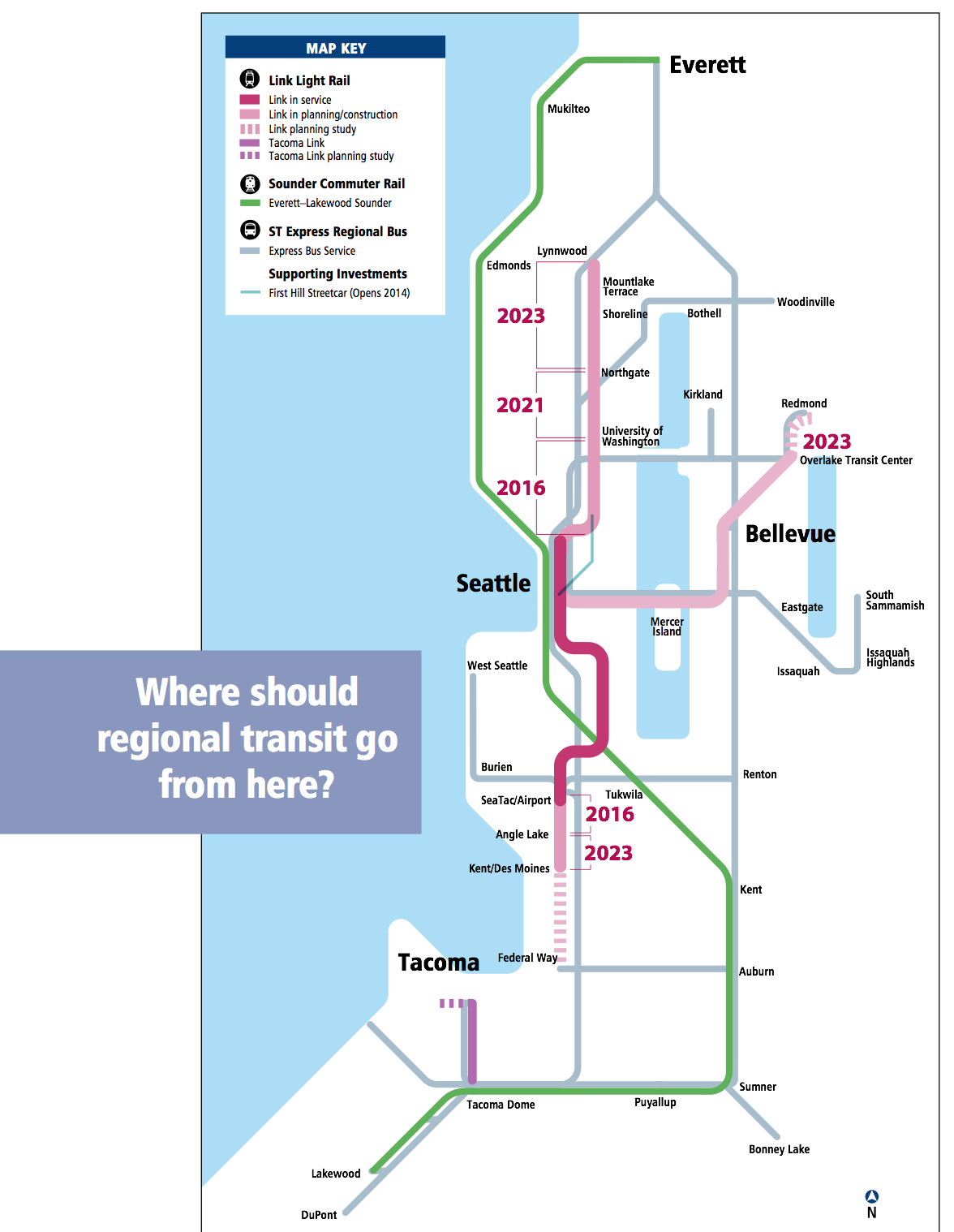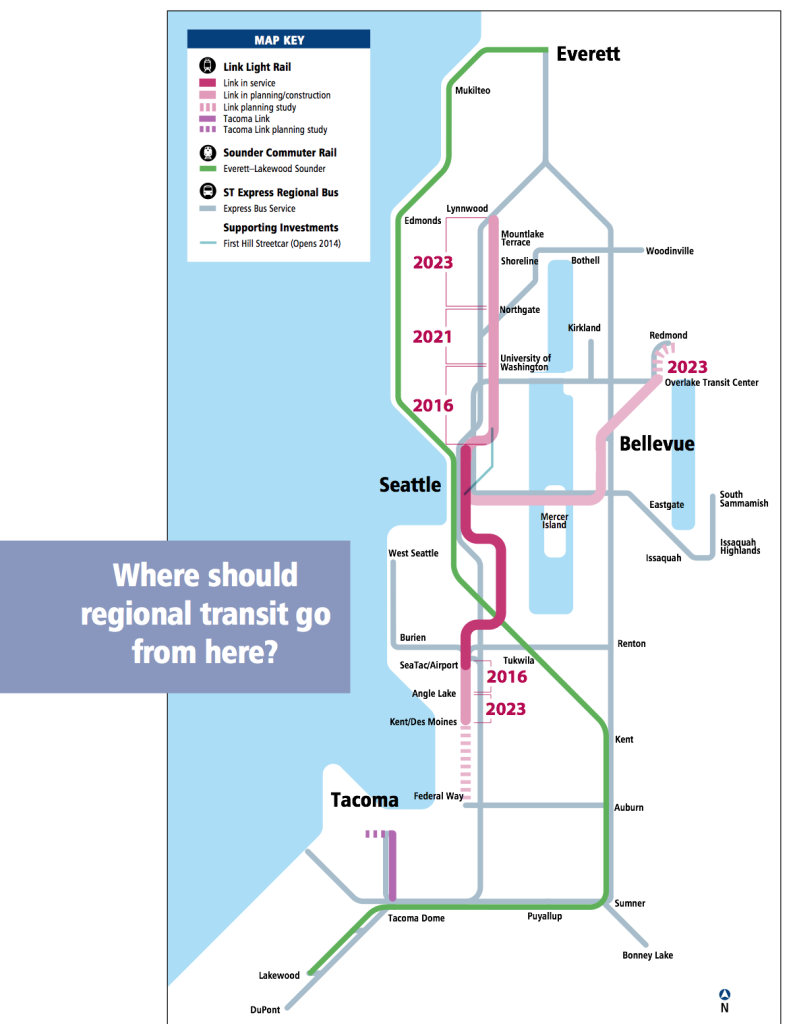Sound Transit, the regional transit agency that builds Link and Sounder rail services and operates a lot of our express buses, is currently updating their Long Range Plan – a list of projects that informs their future expansion. This is the first phase of any ballot measure for additional Sound Transit service. As someone watching this process closely, this seems like a perfect time to talk about how an idea in an advocate’s head becomes a project serving the public!
Long Range Plan
At a very high level – everything starts with advocacy. To move forward on any project, someone must first convince Sound Transit staff, and eventually the Sound Transit Board, to add that project to the agency’s Long Range Plan – an Environmental Impact Statement (EIS) first finalized in 1993. This EIS was updated with a Supplemental EIS (SEIS) in 2005, prior to placing Sound Transit 2 on the ballot, and now, in preparation for a potential Sound Transit 3, it will be updated with a new SEIS.
This document is a holistic look at the whole Sound Transit system and how it might expand: those projects that have already opened, those funded or under construction, and those that might be funded someday. The Long Range Plan is financially unconstrained – it isn’t worried about how much funding authority Sound Transit has now, or even how much funding they might win in a future vote. It’s intended to be a menu of projects the agency might build in the foreseeable future, with some, but variable, understanding of their scope and cost, and how those projects would fit into what’s already on the way.
The current update started in 2013, and should be complete by the end of this year. There’s a lot of public input gathered throughout, as with any EIS, and at the end, Sound Transit will release a new plan to the public, showing us all the directions we’ve asked them to go.
Revenue Authority
Before that work is even over, Sound Transit must also begin to lobby the legislature for revenue authority – the right to ask voters for more funding. Sound Transit is currently using nearly all of their existing revenue to build projects voters have approved, and will be paying those projects off for many years to come. To build more anytime before the late 2020s, they’ll need the authority to ask voters for more money.
Even without the current deadlocked legislature, this is difficult work. Not only does the Sound Transit board have to find a set of projects that are likely to poll well when paired with a particular source of revenue, they have to balance public demand in their own cities and districts with the interests of legislators – and grassroots supporters, major employers, business, labor, and environmental organizations, and engineering and construction firms – all the players who will help bankroll a ballot measure as well as their own elections. The Long Range Plan helps protect Sound Transit from some of these external pressures; by forcing the board to select from a list of somewhat vetted projects, there’s some barrier to terrible projects making it to the ballot.
System Plan
After identifying a revenue source and the bulk of the projects, Sound Transit uses their selections from the LRP ‘menu’ to create a System Plan that they might put to voters.
The first System Plan Sound Transit created was put to voters in 1995 and failed, but after modifying the plan, it passed in 1996, first funding Sound Transit projects. This same failure followed by success repeated in 2007 and 2008, with the final vote funding expansion of Sounder service, express bus service, and Link light rail north to Lynnwood, east to Bellevue and Overlake, and south to Federal Way (although with the recession, light rail will only reach Highline Community College for now).
A System Plan is financially constrained, including local revenue, bonding plans, and expectations for federal grants, and it includes a timeline. We don’t have time machines yet, so it’s hard to predict what a given source of revenue can achieve as the economy changes, both in how much is collected and in the cost of all the goods and services Sound Transit has to purchase to build a project, but Sound Transit increasingly plans conservatively to mitigate those risks.
If Sound Transit is too conservative, the System Plan will be too small or too slow to excite enough voters, and it will fail. If they aren’t conservative enough, though, projects will be visibly delayed and over-budget, dampening public opinion for their future legislative and voter needs.
Expert Review Panel
Before going to the voters, Sound Transit’s enabling legislation has one more requirement – they must submit their System Plan to a state expert review panel, adding months to the development of a ballot measure. As far as I understand, the expert review panel has never found a major issue in a System Plan. The import of this process seems to be almost entirely making the state government comfortable with the agency’s decisions – exerting power above and beyond the purse strings of revenue authority, a Dillon Rule artifact. As an aside, if I’m wrong about this, email me!
The Ballot Measure
Finally, once the System Plan is approved by the state, Sound Transit puts it to the voters. The board votes to submit a ballot measure to Pierce, King, and Snohomish counties. Sound Transit can’t spend money on campaigns, though, so in the meantime, a campaign is filed with the state’s Public Disclosure Commission, and all the advocates, companies, and organizations I mentioned before put in a lot of money and time to win.
As I noted, this has happened four times so far – March 1995 and November 1996, and then November 2007 and November 2008.
The Four Elections
Different election years dramatically affect voter turnout: some people vote in every election, and tend to be older, whiter, and more well off; a more conservative electorate. The more spent by the campaigns and the more media covering the election, the more younger, more diverse, and more progressive people are reminded (or convinced) to vote. Turnout is far higher in a Presidential election than any other year.
Both of these pairs Sound Transit votes consist of a non-mayoral, non-legislative election followed by a Presidential election year. In 1995/1996, Sound Transit chose a conservative year followed by a progressive year – in fact, the original ballot measure in 1995 was a special election, the lowest possible turnout and most conservative electorate they could have chosen. In 2006, Sound Transit was prepared to go to the voters, but the state legislature asked them to wait until 2007 to be paired with highway expansion. In 2008, Sound Transit went to the ballot again by themselves and solidly passed. It’s possible that the highway expansion caused failure of the package (and I would love that to be the case), but I think it can just as easily be explained by the low turnout and more conservative electorate.
Far more people voted against Sound Transit when it passed than when it failed. Let me say that again: some 50% more people voted against Sound Transit 2 in the year it passed, 2008, than in the year it failed, 2007 (King 07, King 08, Pierce 07, Pierce 08, Snohomish 07, Snohomish 08). In the year when it passed, though, turnout was dramatically higher – the new ‘yes’ votes overwhelmed the new ‘no’ votes.
Suffice it to say, we should be aiming for a Sound Transit 3 vote in 2016.
The Future
We’ll be writing more about the Long Range Plan update as it continues, as well as particular projects that we can champion. Once Metro is saved, helping Sound Transit win revenue authority will be the next step on the path to Sound Transit 3, and you’ll hear more from us about lobbying existing legislators, as well as electing some new transit friendly faces.



